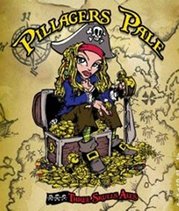I've been holding onto this article about three pervasive wine myths from The Professional Friends of Wine for a few weeks now, reading and rereading it. It's finally time to share it with you, loyal readers. Take a look, learn something new, and then I command you to go out tonight and drink some wine!
Recently in Musings Category
The other day I came across an article about a Belgian beer brewed during the full moon, which claims that, apparently, yeast is more active during the full moon, giving the beer "an extra punch."
Is that really true? I'd like to hear from some brewers about this. Do you want a quick, vigorous fermentation, or a long, slow one? Does the speed of fermentation really affect the flavor of the beer that much in the end? My impression has always been that a faster fermentation means that the wort is warmer than usual, and that yeast fermenting in hotter environments can produce strange off flavors. But in this beer's case, the speed comes from the full moon. I mean, if that can actually happen.
Homebrewers, brewmasters, chime in and let us know what's up with this sort of thing.
On Tuesday, Martyn Cornell published an excellent article in which he dives into the differences between old ale and barleywine, and after a bit of a foray into the history of mild ale and the historical difference between "ale" and "beer", finally comes to an interesting conclusing. I won't spoil it for you, though. Go and read his article, because he's a great writer and you shouldn't pass him up.
Mr. Cornell's articles frequently include some great examples of old advertisements, and my favorite in this one is the ad for Smith & Bruce's Barrack Ground Brewery, which has a couple of Masonic symbols in it. It's very neat to spot that sort of thing in a beer ad.
In North America, the barleywines tend to be split pretty evenly between the more old-fashioned English barleywine and the newfangled American barleywine. The latter is certainly an extreme beer, being overly malty and usually heavily hopped. Personally, the English style is preferred, with a slightly subdued malt character, well-balanced hops, and a slightly lower ABV that makes it an excellent brew to sip by a roaring fire in the winter.
Of course, in Costa Rica there are neither winters nor roaring fires to sit by. But I will bide my time, because such things are certainly in my future somewhere.
David Malki over at Wondermark recently delved into what he calls the "Oenophile's Quandry". When is an occasion special enough to merit that special bottle of wine? It's a common problem facing those with collections of tasty beverages (see, for instance, this conversation over on Snooth), and I have in the past encountered champagne past its expiration date because that special occasion never arrived.
Psychologists have examined this problem, too, and perhaps it's wiser to approach it from that point of view instead of the economist's. Basically, opening that special bottle is a special occasion all on its own, so please go for it. Drink up!
 As I mentioned in my recent interview, I'm currently reading Vanity Fair by William Makepeace Thackeray. Vera and I are also planning a long stay in Costa Rica, a country which seems to be woefully short on quality beer. So when I came across this great passage in the book, it really struck a chord with me, and though I'm not sure if London's 19th century porters would have had the same effect today, the sentiment is still sound.
As I mentioned in my recent interview, I'm currently reading Vanity Fair by William Makepeace Thackeray. Vera and I are also planning a long stay in Costa Rica, a country which seems to be woefully short on quality beer. So when I came across this great passage in the book, it really struck a chord with me, and though I'm not sure if London's 19th century porters would have had the same effect today, the sentiment is still sound.
"If I had time and dared to enter into digressions, I would write a chapter about that first pint of porter drunk upon English ground. Ah, how good it is! It is worth while to leave home for a year, just to enjoy that one draught."
There is one beer whose clarity, complexity, and subtlety make it seem to me like perhaps one of the most difficult to brew and brew well. This style, maligned by both old-school hop-heads and newcomers to the world of craft beer, is the venerable Pilsner. I can understand why the Pilsner would be a difficult style, though, because until recently, I had similar feelings lurking in my beer-soul.
Pilsners are usually described as well-hopped, but with today's hop-heavy IPAs, CDAs, and imperial beers, it is difficult to wrap one's palate around this golden style's hop character. The best way to approach a Pilsner tasting is to avoid any hoppy beers ahead of time. Hops can really be murder on one's palate, and when experiencing the subtleties of this style, you want your mouth and tongue to be fresh.
Select several Pilsners and try them side-by-side. If selecting American varieties, at first steer clear of the heavier takes on it, such as the Victory Prima Pils, and try something lighter and cleaner, like Oskar Blues Mama's Little Yella Pils. Definitely include at least one Czech variety, and do not pass up the German classics such as Paulaner Premium. Pour your Pilsner into a genuine Pilsner glass, and give it a good, creamy head at least two fingers thick. The aroma should easily present to one's nose a complex bouquet of hops, an interesting yeast, and a promise of the malty delights to come.
One should keep in mind that this beer is lagered for several months before being bottled, and that it was quite possibly one of the first clear beer styles ever brewed. Enjoy the Pilsner's beauty, reflect on the level of craftsmanship needed to brew and lager it, and sip slowly. After understanding these elements of the beer, it's perfectly all right to pour yourself a Mass of this wonderful nectar, and gulp away.
Pilsners are usually described as well-hopped, but with today's hop-heavy IPAs, CDAs, and imperial beers, it is difficult to wrap one's palate around this golden style's hop character. The best way to approach a Pilsner tasting is to avoid any hoppy beers ahead of time. Hops can really be murder on one's palate, and when experiencing the subtleties of this style, you want your mouth and tongue to be fresh.
Select several Pilsners and try them side-by-side. If selecting American varieties, at first steer clear of the heavier takes on it, such as the Victory Prima Pils, and try something lighter and cleaner, like Oskar Blues Mama's Little Yella Pils. Definitely include at least one Czech variety, and do not pass up the German classics such as Paulaner Premium. Pour your Pilsner into a genuine Pilsner glass, and give it a good, creamy head at least two fingers thick. The aroma should easily present to one's nose a complex bouquet of hops, an interesting yeast, and a promise of the malty delights to come.
One should keep in mind that this beer is lagered for several months before being bottled, and that it was quite possibly one of the first clear beer styles ever brewed. Enjoy the Pilsner's beauty, reflect on the level of craftsmanship needed to brew and lager it, and sip slowly. After understanding these elements of the beer, it's perfectly all right to pour yourself a Mass of this wonderful nectar, and gulp away.
In 1998 or 1999, I had the opportunity to sample Samuel Adam's legendary Triple Bock. It was in its cobalt-blue bottle, poured into snifters. I had certainly tried quite a few beers back then, but was not as much of a beer nerd as I am now. I remember the beer was viscous, flat with a dark, murky color. It smelled rich, sherry-like, and intense, but to me seemed overwhelmingly odd and syrupy, and thus undrinkable.
I have since had a number of ultra-strong beers, including the World Wide Stout and 120 Minute IPA from Dogfish Head, the Goose Island Bourbon County Stout, Deschutes Abyss, and others. To my palate, they range from sticky, sweet, and only good for the novelty, to really impressive examples of the craft of beer. And I am sure that, like the various imperial styles, brewing such intense beers really helps brewmasters understand more about the process and their recipes.
Currently, however, there seems to be an arms race in the brewing world to make the strongest possible beer. BrewDog in Scotland and Schorschbräu in Germany are at the head of the race, popping out beers that are actually surpassing 80 proof. These beers push the definition of "extreme beer," and though I doubt I'll get a chance to try one anytime soon (the Schorschbräu Schorschbock costs around $150), I'm also not sure I would really leap at the opportunity to have a bottle around every day. The reviews make them sound interesting, but not exactly drinkable.
We at Leisure Nouveau would be very interested in hearing from readers who have tried one of these extreme beers. Please leave us a comment below.
I have since had a number of ultra-strong beers, including the World Wide Stout and 120 Minute IPA from Dogfish Head, the Goose Island Bourbon County Stout, Deschutes Abyss, and others. To my palate, they range from sticky, sweet, and only good for the novelty, to really impressive examples of the craft of beer. And I am sure that, like the various imperial styles, brewing such intense beers really helps brewmasters understand more about the process and their recipes.
Currently, however, there seems to be an arms race in the brewing world to make the strongest possible beer. BrewDog in Scotland and Schorschbräu in Germany are at the head of the race, popping out beers that are actually surpassing 80 proof. These beers push the definition of "extreme beer," and though I doubt I'll get a chance to try one anytime soon (the Schorschbräu Schorschbock costs around $150), I'm also not sure I would really leap at the opportunity to have a bottle around every day. The reviews make them sound interesting, but not exactly drinkable.
We at Leisure Nouveau would be very interested in hearing from readers who have tried one of these extreme beers. Please leave us a comment below.
 This afternoon as I sat back to enjoy a few pints of beer, I cracked open a bottle of Three Skulls Ales' Pillagers Pale, which poured a rich, slightly cloudy gold and produced a wonderful off-white head that proved to have good retention and a lovely, solid lacing. As I leaned forward to sniff the beer, I contemplated the recently discovered "G-variant", or Churchill gene, which apparently causes alcohol to have more of a creativity-inspiring opiate effect instead of instilling that common sottish idiocy we've all seen so often before. But I didn't have time to contemplate much before encountering the odd, yeast-heavy aroma of this particular pale ale, which seems out of place with this particular style. I sniffed again, and indeed it has a curious bready odor almost entirely masking the mild hops beneath.
This afternoon as I sat back to enjoy a few pints of beer, I cracked open a bottle of Three Skulls Ales' Pillagers Pale, which poured a rich, slightly cloudy gold and produced a wonderful off-white head that proved to have good retention and a lovely, solid lacing. As I leaned forward to sniff the beer, I contemplated the recently discovered "G-variant", or Churchill gene, which apparently causes alcohol to have more of a creativity-inspiring opiate effect instead of instilling that common sottish idiocy we've all seen so often before. But I didn't have time to contemplate much before encountering the odd, yeast-heavy aroma of this particular pale ale, which seems out of place with this particular style. I sniffed again, and indeed it has a curious bready odor almost entirely masking the mild hops beneath.In any case, according to a recent article in Prospect Magazine, about 15% of Caucasians possess this miraculous variant, which was named after Winston Churchill because of his life-long love for alcohol and his legendary consumption. But how legendary was his consumption, really? It has been argued that his omnipresent scotch-and-water was but a smidgeon of the strong stuff liberally laced with the weak, and that the man used his reputation to his advantage, but certainly knew his limits. Nevertheless, it's truly inspiring to see that science has finally acknowledged that some good can come to the creative mind from a modest tipple or two.
As I pondered these heavy thoughts, my tastebuds were hard at work on the Pillagers Pale. It has a very nutty, roasted malt flavor that does a good job masking the hops. I would suggest that it's perhaps too good a job, and that there are certain aspects of this beer that depart from what one would usually expect from a good pale ale. However, it is not a bad beer, and if one is ready for the unexpected, it can certainly be readily enjoyed.

 By
By 














